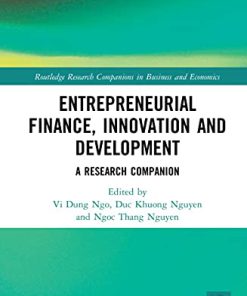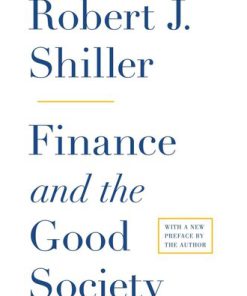Entrepreneurial Finance 7th edition by Chris Leach, Ronald Melicher 0357442040 9780357442043
$50.00 Original price was: $50.00.$25.00Current price is: $25.00.
Entrepreneurial Finance 7th edition by Chris Leach, Ronald Melicher – Ebook PDF Instant Download/Delivery: 0357442040, 9780357442043
Full download Entrepreneurial Finance 7th edition after payment

Product details:
ISBN 10: 0357442040
ISBN 13: 9780357442043
Author: J. Chris Leach; Ronald W. Melicher
Guide students through a complete “life cycle of the firm” with Leach/Melicher’s ENTREPRENEURIAL FINANCE, 7E. This leading text introduces the theories, knowledge and corporate finance tools and techniques today’s entrepreneur needs to start, build and eventually harvest a successful venture. Students learn how to secure financing, use business cash flow models and strategically position their early-stage companies as this edition emphasizes sound financial management practices. Students also learn how to interact effectively with financial institutions and regulatory agencies that can affect venture growth and ensure liquidity for investors. Whether in print or full-color eBook form, this edition’s capstone cases, mini-cases and examples draw from actual entrepreneurial ventures and the latest financial scenarios to illustrate important concepts, such as venture capital funds, institutional investors, strategic alliances, the role of business angels, licensing agreements and exit strategies.
Entrepreneurial Finance 7th Table of contents:
Part 1. The Entrepreneurial Environment
Chapter 1. Introduction to Finance for Entrepreneurs
Section 1.1. The Entrepreneurial Process
Section 1.2. Entrepreneurship Fundamentals
Who Is an Entrepreneur?
Basic Definitions
Entrepreneurial Traits or Characteristics
Opportunities Exist but not Without Risks
Section 1.3. Sources of Entrepreneurial Opportunities
Societal Changes
Demographic Changes
Technological Changes
Emerging Economies and Global Changes
Crises and “Bubbles”
Disruptive Innovation
Section 1.4. Principles of Entrepreneurial Finance
Real, Human, and Financial Capital Must Be Rented from Owners (Principle #1)
Risk and Expected Reward Go Hand in Hand (Principle #2)
While Accounting Is the Language of Business, Cash Is the Currency (Principle #3)
New Venture Financing Involves Search, Negotiation, and Privacy (Principle #4)
A Venture’s Financial Objective Is to Increase Value (Principle #5)
It Is Dangerous to Assume That People Act against their Own Self-Interests (Principle #6)
Venture Character and Reputation Can Be Assets or Liabilities (Principle #7)
Section 1.5. Role of Entrepreneurial Finance
Section 1.6. The Successful Venture Life Cycle
Development Stage
Startup Stage
Survival Stage
Rapid-Growth Stage
Early-Maturity Stage
Life Cycle Stages and the Entrepreneurial Process
Section 1.7. Financing Through the Venture Life Cycle
Seed Financing
Startup Financing
First-Round Financing
Second-Round Financing
Mezzanine Financing
Liquidity-Stage Financing
Seasoned Financing
Section 1.8. Life Cycle Approach for Teaching Entrepreneurial Finance
Summary
Key Terms
Discussion Questions
Internet Activities
Exercises/Problems
Supplemental Exercises/Problems
Chapter 2. Developing the Business Idea
Section 2.1. Process for Identifying Business Opportunities
Section 2.2. To Be Successful, You Must Have a Sound Business Model
Component 1: The Business Model Must Generate Revenues
Component 2: The Business Model Must Make Profits
Component 3: The Business Model Must Produce Free Cash Flows
Section 2.3. Learn from the Best Practices of Successful Entrepreneurial Ventures
Best Marketing Practices
Best Financial Practices
Best Management Practices
Best Production or Operations Practices Are Also Important
Section 2.4. Time-to-Market and Other Timing Implications
Section 2.5. Initial “Litmus Test” for Evaluating the Business Feasibility of an Idea
Section 2.6. Screening Venture Opportunities
An Interview With the Founder (Entrepreneur) and Management Team: Qualitative Screening
Scoring a Prospective New Venture: Quantitative Screening
Industry/Market Considerations
Pricing/Profitability Considerations
Financial/Harvest Considerations
Management Team Considerations
Opportunity Screening Caveats
Section 2.7. Key Elements of a Business Plan
Cover Page, Confidentiality Statement, and Table of Contents
Executive Summary
Business Description
Marketing Plan and Strategy
Operations and Support
Management Team
Financial Plans and Projections
Risks and Opportunities
Business Plan Appendix
Summary
Key Terms
Discussion Questions
Internet Activities
Exercises/Problems
Supplemental Exercises/Problems
Appendix A. Applying the VOS Indicator™: An Example
Part 2. Organizing and Operating the Venture
Chapter 3. Organizing and Financing a New Venture
Section 3.1. Progressing Through the Venture Life Cycle
Section 3.2. Forms of Business Organization
Proprietorships
General and Limited Partnerships
Corporations
Limited Liability Companies
Section 3.3. Choosing the Form of Organization: Tax and Other Considerations
Section 3.4. Intellectual Property
Protecting Valuable Intangible Assets
What Kinds of Intellectual Property Can Be Protected?
Patents
Trade Secrets
Trademarks
Copyrights
Other Methods for Protecting Intellectual Property Rights
Confidential Disclosure Agreements (Nondisclosure Agreements)
Employment Contracts
Section 3.5. Seed, Startup, and First-Round Financing Sources
Financial Bootstrapping
Business Angel Funding
First-Round Financing Opportunities
Summary
Key Terms
Discussion Questions
Internet Activities
Exercises/Problems
Supplemental Exercises/Problems
Chapter 4. Preparing and Using Financial Statements
Section 4.1. Obtaining and Recording the Resources Necessary to Start and Build a New Venture
Section 4.2. Business Assets, Liabilities, and Owners, Equity
Balance Sheet Assets
Liabilities and Owners’ Equity
Section 4.3. Sales, Expenses, and Profits
Section 4.4. Internal Operating Schedules
Section 4.5. Statement of Cash Flows
Section 4.6. Operating Breakeven Analyses
Survival Breakeven
Identifying Breakeven Drivers in Revenue Projections
Summary
Key Terms
Discussion Questions
Internet Activities
Exercises/Problems
Appendix A. NOPAT Breakeven: Revenues Needed to Cover Total Operating Costs
Chapter 5. Evaluating Operating and Financial Performance
Section 5.1. Users of Operating and Financial Performance Measures by Life Cycle Stage
Section 5.2. Using Financial Ratios
Section 5.3. Cash Burn Rates and Liquidity Ratios
Measuring Venture Cash Burn and Build Amounts and Rates
Beyond Burn: Traditional Measures of Liquidity
Interpreting Cash-Related and Liquidity-Related Trends
Section 5.4. Leverage Ratios
Measuring Financial Leverage
Interpreting Changes in Financial Leverage
Section 5.5. Profitability and Efficiency Ratios
Income Statement Measures of Profitability
Efficiency and Return Measures
Interpreting Changes in Profitability and Efficiency
Section 5.6. Industry Comparable Ratio Analysis
Section 5.7. A Hitchhiker’s Guide to Financial Analysis
Summary
Key Terms
Discussion Questions
Internet Activities
Exercises/Problems
Part 3. Planning for the Future
Chapter 6. Managing Cash Flow
Section 6.1. Financial Planning Throughout the Venture’s Life Cycle
Section 6.2. Surviving in the Short Run
Section 6.3. Short-Term Cash-Planning Tools
Section 6.4. Projected Monthly Financial Statements
Section 6.5. Cash Planning from a Projected Monthly Balance Sheet
Section 6.6. Conversion Period Ratios
Measuring Conversion Times
Interpreting Changes in Conversion Times
Summary
Key Terms
Discussion Questions
Internet Activities
Exercises/Problems
Spreadsheet Exercises/Problems
Chapter 7. Types and Costs of Financial Capital
Section 7.1. Implicit and Explicit Financial Capital Costs
Section 7.2. Financial Markets
Section 7.3. Determining the Cost of Debt Capital
Determinants of Market Interest Rates
Risk-Free Interest Rate
Default Risk Premium
Liquidity and Maturity Risk Premiums
A Word on Venture Debt Capital
Section 7.4. What Is Investment Risk?
Measuring Risk as Dispersion around an Average
Historical Return versus Risk Relationships
Section 7.5. Estimating the Cost of Equity Capital
Cost of Equity Capital for Public Corporations
Cost of Equity Capital for Private Ventures
Sources and Costs of Venture Equity Capital
Section 7.6. Weighted Average Cost of Capital
A Life Cycle–Based WACC Example
Summary
Key Terms
Discussion Questions
Internet Activities
Exercises/Problems
Appendix A. Using WACC to Complete the Calibration of EVA
Chapter 8. Securities Law Considerations When Obtaining Venture Financing
Section 8.1. Review of Sources of External Venture Financing
Section 8.2. Overview of Federal and State Securities Laws
Securities Act of 1933
Securities Exchange Act of 1934
Investment Company Act of 1940
Investment Advisers Act of 1940
Jumpstart Our Business Startups Act of 2012
State Securities Regulations: “Blue-Sky” Laws
Section 8.3. Process for Determining Whether Securities Must Be Registered
Offer and Sale Terms
What Is a Security?
Section 8.4. Registration of Securities under the Securities Act of 1933
Section 8.5. Security Exemptions from Registration under the 1933 Act
Section 8.6. Transaction Exemptions from Registration under the 1933 Act
Private Offering Exemption
Accredited Investor Exemption
Section 8.7. SEC’s Regulation D: Safe-Harbor Exemptions
Rule 504: Exemption for Limited Offerings and Sales of Securities Not Exceeding $5 Million
Rule 506: Exemption for Limited Offers and Sales Without Regard to Dollar Amount of Offering
Section 8.8. Regulation a Security Exemption
Section 8.9. JOBS Act Innovations
Summary
Key Terms
Discussion Questions
Internet Activities
Exercises/Problems
Appendix A. Schedule A (Securities Act of 1933, as Amended)
Appendix B. Selected SEC Regulation D Materials
Appendix C. Other Forms of Registration Exemptions and Breaks
Part 4. Creating and Recognizing Venture Value
Chapter 9. Projecting Financial Statements
Section 9.1. Long-Term Financial Planning Throughout the Venture’s Life Cycle
Section 9.2. Beyond Survival: Systematic Forecasting
Forecasting Sales for Seasoned Firms
Forecasting Sales for Early-Stage Ventures
Section 9.3. Estimating Sustainable Sales Growth Rates
Section 9.4. Estimating Additional Financing Needed to Support Growth
The Basic Additional Funds Needed Equation
Impact of Different Growth Rates on AFN
Estimating the AFN for Multiple Years
Section 9.5. Percent-of-Sales Projected Financial Statements
Forecasting Sales
Projecting the Income Statement
Projecting the Balance Sheet
Forecasting the Statement of Cash Flows
Financing Cost Implications Associated with the Need for Additional Funds
Summary
Key Terms
Discussion Questions
Internet Activities
Exercises/Problems
Spreadsheet Exercises/Problems
Chapter 10. Valuing Early-Stage Ventures
Section 10.1. What Is a Venture Worth?
Does the Past Matter?
Looking to the Future
Vested Interests in Value: Investor and Entrepreneur
Section 10.2. Basic Mechanics of Valuation: Mixing Vision and Reality
Present Value Concept
If You’re Not Using Estimates, You’re Not Doing a Valuation
Divide and Conquer with Discounted Cash Flow
Section 10.3. Required versus Surplus Cash
Section 10.4. Developing the Projected Financial Statements for a DCF Valuation
Section 10.5. Just-In-Time Equity Valuation: Pseudo Dividends
Section 10.6. Accounting versus Equity Valuation Cash Flow
Origins of Accounting Cash Flows
From Accounting to Equity Valuation Cash Flows
Summary
Key Terms
Discussion Questions
Internet Activities
Exercises/Problems
Spreadsheet Valuation Problem
Learning Supplement 10A. Value Maximization and the First Entrepreneurial Team
Learning Supplement 10B. Discounting Growing Perpetuities
Chapter 11. Venture Capital Valuation Methods
Section 11.1. Brief Review of Basic Cash Flow-Based Equity Valuations
Section 11.2. Basic Venture Capital Valuation Method
Using Present Values
Using Future Values
Section 11.3. Earnings Multipliers and Discounted Dividends
Section 11.4. Adjusting VCSCs for Multiple Rounds
First Round
Second Round
Section 11.5. Adjusting VCSCs for Incentive Ownership
First Round
Second Round
Incentive Ownership Round
Section 11.6. Adjusting VCSCs for Payments to Senior Security Holders
Section 11.7. Introducing Scenarios to VCSCs
Utopian Approach
Mean Approach
Summary
Key Terms
Discussion Questions
Internet Activities
Exercises/Problems
Learning Supplement 11A. Sustainable Growth
Learning Supplement 11B. PDC’s Equity Valuation: Synthesizing Equity Method and VCSC Valuations (Advanced)
Part 5. Structuring Financing for the Growing Venture
Chapter 12. Professional Venture Capital
Section 12.1. Historical Characterization of Professional Venture Capital
Section 12.2. Professional Venture Investing Cycle: Overview
Section 12.3. Determining (Next) Fund Objectives and Policies
Section 12.4. Organizing the New Fund
Section 12.5. Soliciting Investments in the New Fund
Section 12.6. Obtaining Commitments for a Series of Capital Calls
Section 12.7. Conducting Due Diligence and Actively Investing
Section 12.8. Arranging Harvest or Liquidation
Section 12.9. Distributing Cash and Securities Proceeds
Summary
Key Terms
Discussion Questions
Internet Activities
Exercises/Problems
Chapter 13. Other Financing Alternatives
Section 13.1. Business Incubators, Seed Accelerators, and Intermediaries
Business Incubators and Seed Accelerators
Intermediaries, Facilitators, and Consultants
Section 13.2. Business Crowdsourcing and Crowdfunding
Section 13.3. Commercial and Venture Bank Lending
Section 13.4. Understanding Why You May Not Get Debt Financing
Section 13.5. Credit Cards
Section 13.6. Foreign Investor Funding Sources
Section 13.7. Small Business Administration Programs
Overview of What the SBA Does for Small Businesses
Selected SBA Loan and Operating Specifics
Section 13.8. Other Government Financing Programs
Section 13.9. Factoring, Receivables Lending, and Customer Funding
Section 13.10. Debt, Debt Substitutes, and Direct Offerings
Vendor Financing: Accounts Payable and Trade Notes
Mortgage Lending
Traditional and Venture Leasing
Direct Public Offers
Summary
Key Terms
Discussion Questions
Internet Activities
Exercises/Problems
Appendix A. Summary of Colorado Business Financial Assistance Options
Chapter 14. Security Structures and Determining Enterprise Values
Section 14.1. Common Stock or Common Equity
Section 14.2. Preferred Stock or Preferred Equity
Selected Characteristics
Convertible Preferreds
Conversion Value Protection
Conversion Protection Clauses
Conversion Price Formula (CPF)
Market Price Formula (MPF)
Section 14.3. Convertible Debt
Section 14.4. Warrants and Options
Section 14.5. Other Concerns about Security Design
Section 14.6. Valuing Ventures with Complex Capital Structures: the Enterprise Method
Summary
Key Terms
Discussion Questions
Internet Activities
Exercises/Problems
Learning Supplement 14A. Alternative Enterprise Valuation Method
Learning Supplement 14B. Application of Black-Scholes Option-Pricing Formula
Part 6. Exit and Turnaround Strategies
Chapter 15. Harvesting the Business Venture Investment
Section 15.1. Venture Operating and Financial Decisions Revisited
Section 15.2. Planning an Exit Strategy
Section 15.3. Valuing the Equity or Valuing the Enterprise
Relative Valuation Methods
Dividing the Venture Valuation Pie
Section 15.4. Systematic Liquidation
Section 15.5. Outright Sale
Family Members
Managers
Employees
Outside Buyers
Section 15.6. Going Public
Investment Banking
Some Additional Definitions
Other Costs in Issuing Securities
Post-IPO Trading
Contemplating and Preparing for the IPO Process
Summary
Key Terms
Discussion Questions
Exercises/Problems
Chapter 16. Financially Troubled Ventures: Turnaround Opportunities?
Section 16.1. Venture Operating and Financing Overview
Section 16.2. The Troubled Venture and Financial Distress
Balance Sheet Insolvency
Cash Flow Insolvency
Temporary versus Permanent Cash Flow Problems
Section 16.3. Resolving Financial Distress Situations
Operations Restructuring
Asset Restructuring
Financial Restructuring
Section 16.4. Private Workouts and Liquidations
Private Workouts
Private Liquidations
Venture Example: Jeremy’s Microbatch Ice Creams, Inc.
Section 16.5. Federal Bankruptcy Law
Bankruptcy Reorganizations
Reasons for Legal Reorganizations
Legal Reorganization Process
Bankruptcy Liquidations
Summary
Key Terms
Discussion Questions
Internet Activities
Exercises/Problems
Part 7. Capstone Cases
Capstone Case 1. Eco-Products, Inc.
Background
The Company
Surviving the Early Years: 1991–2003
Building a New Division: 1996–2000
A Growing Team for a Growing Business: 2004–2005
A New Direction: 2005–2007
The “Eco-Products” Label
Competitors
The Perfect Storm: 2007
Financial Performance: 2005–2007
The Cash Vortex: 2008
Negotiating a Strategic Partnership: July 2008
Assignments
Appendix A. Excerpts from Eco-Products, Inc., 2007 Private Placement Memorandum
Appendix B. Investment Terms Sheet—Greenmont Capital Partners
Capstone Case 2. Spatial Technology, Inc
The Origin of Spatial Technology
Early Company History
After the Restructuring
Time to Go Public
The Morning After: A Last Chance?
Assignments
People also search for Entrepreneurial Finance 7th:
8 entrepreneurial characteristics
8 entrepreneurs
7 entrepreneurs
7 types of entrepreneurship
Tags:
Chris Leach,Ronald Melicher,Entrepreneurial,Finance
You may also like…
Romance - Contemporary Romance
Business & Economics - Sales & Marketing
Consumer Behavior 7e 7th Edition Wayne D Hoyer Deborah J Macinnis Rik Pieters
Business & Economics - Markets
Business & Economics - Management & Leadership
Business & Economics - Small Business
Mathematics - Mathematical Statistics
Uncategorized
Computers - Enterprise Computing Systems











